The Irwin Allen classic premiered 60 years ago!
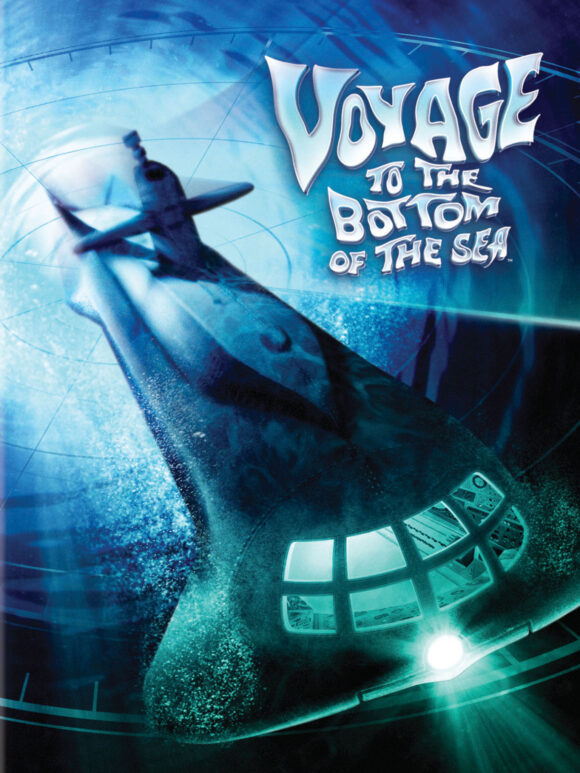
By PETER BOSCH
Debuting September 14, 1964, Voyage to the Bottom of the Sea was Irwin Allen’s first TV show production, setting the way for his subsequent series Lost in Space, The Time Tunnel, and Land of the Giants. Based on the movie of the same name, which was also produced, directed, and co-written by Allen, the casting for the television series was all new (with two exceptions).
For the 60th anniversary of the TV adventure program, here are 13 things to enjoy about the show, which ran until March 31, 1968 on ABC.
—
Irwin Allen. Allen was an old-school type of Hollywood showman. And he went all-out to get there. He started as a salesman in New York, but had an overwhelming desire to be a Hollywood producer… even if he had no experience. He moved to Los Angeles and created a radio talk show about Hollywood productions and made valuable contacts.
Eventually, he got his wish and was involved with the production of motion pictures, among them Double Dynamite (1951) and A Girl in Every Port (1952), both with Groucho Marx, and the original movie version of Voyage to the Bottom of the Sea (1961). Later, he would become known as a master of thrills with ’70s blockbusters such as The Poseidon Adventure (1972) and The Towering Inferno (1974).
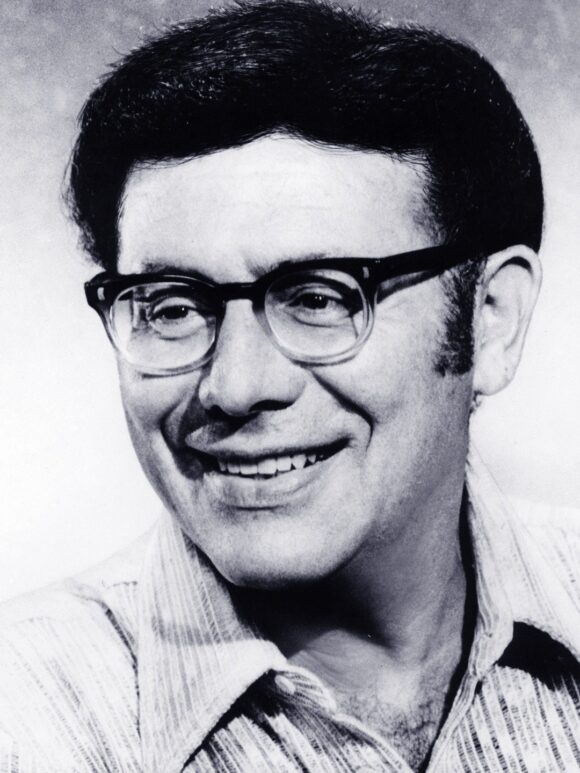
Irwin Allen
—
The Movie. The 1961 film starred Walter Pidgeon as Admiral Harriman Nelson, a brilliant scientist and military man, with the problem of solving the Van Allen radiation belt suddenly catching fire around the world. Also along for the ride were Frankie Avalon, Barbara Eden, and Peter Lorre. (A trivia note: The rubber shark that Peter Lorre’s character works with in the Seaview’s aquarium was also the one that attached itself to Adam West’s leg in the Batman 1966 movie.) Many of the movie’s special effects scenes were used throughout the TV series.
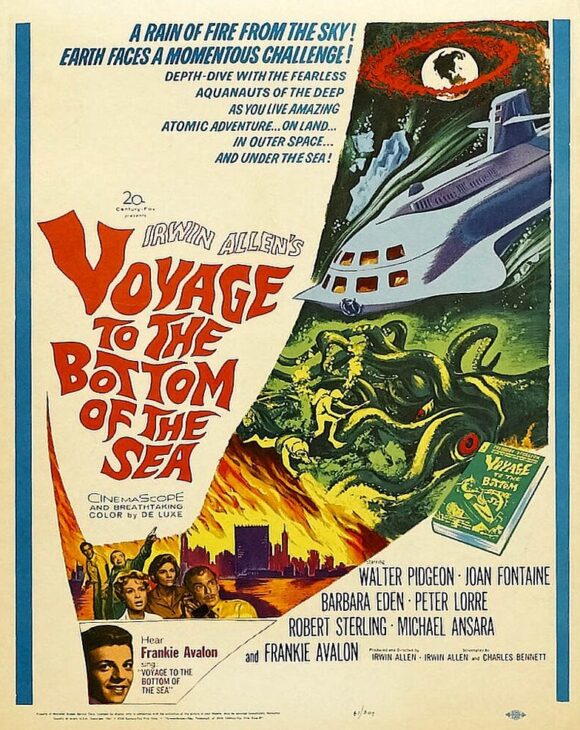
Voyage to the Bottom of the Sea (1961) movie poster.
—
The Pilot. The original television pilot was filmed in color but broadcast in black and white. (The series went to color in the second season.) The series started out dramatically with an earthquake centered in the Arctic causing worldwide damage. A second quake will come, but when it does the tidal waves caused by it will wipe out entire continents and kill millions of people. The Seaview is sent there to plant a nuclear explosive that will halt it, but they are hampered by a secret enemy force that wants the disasters to happen so they can take over the world.
—
The TV Opening Theme: Paul Sawtell was the composer of the theme with its sonar-like blips. His career began in the 1940s and among the films he scored were several Sherlock Holmes, Tarzan, and Dick Tracy movies. He worked steadily for most of his time in Hollywood, including a number of memorable horror and sci-fi pictures, such as the original 1958 version of The Fly (which also had Hedison) and It! The Terror from Beyond Space (also 1958). His last few films included Russ Meyer exploitation flicks.
—
Richard Basehart: A respected actor of stage and screen, he had appeared in the motion pictures He Walked By Night, Fourteen Hours, La Strada, Hitler, and two seafaring tales before Voyage: Titanic (the 1953 version) and Moby Dick. In the late 1950s and early 1960s, he did occasional one-time roles on anthology TV series such as Studio One, Playhouse 90, The Alfred Hitchcock Hour, The Twilight Zone, and the like. And then he signed for his most famous role, Admiral Harriman Nelson in Voyage to the Bottom of the Sea.
Recommended Richard Basehart episode to watch: “The Deadly Dolls” Season 4, Episode 2. (Basehart also supplies the evil voice of his lookalike puppet.)
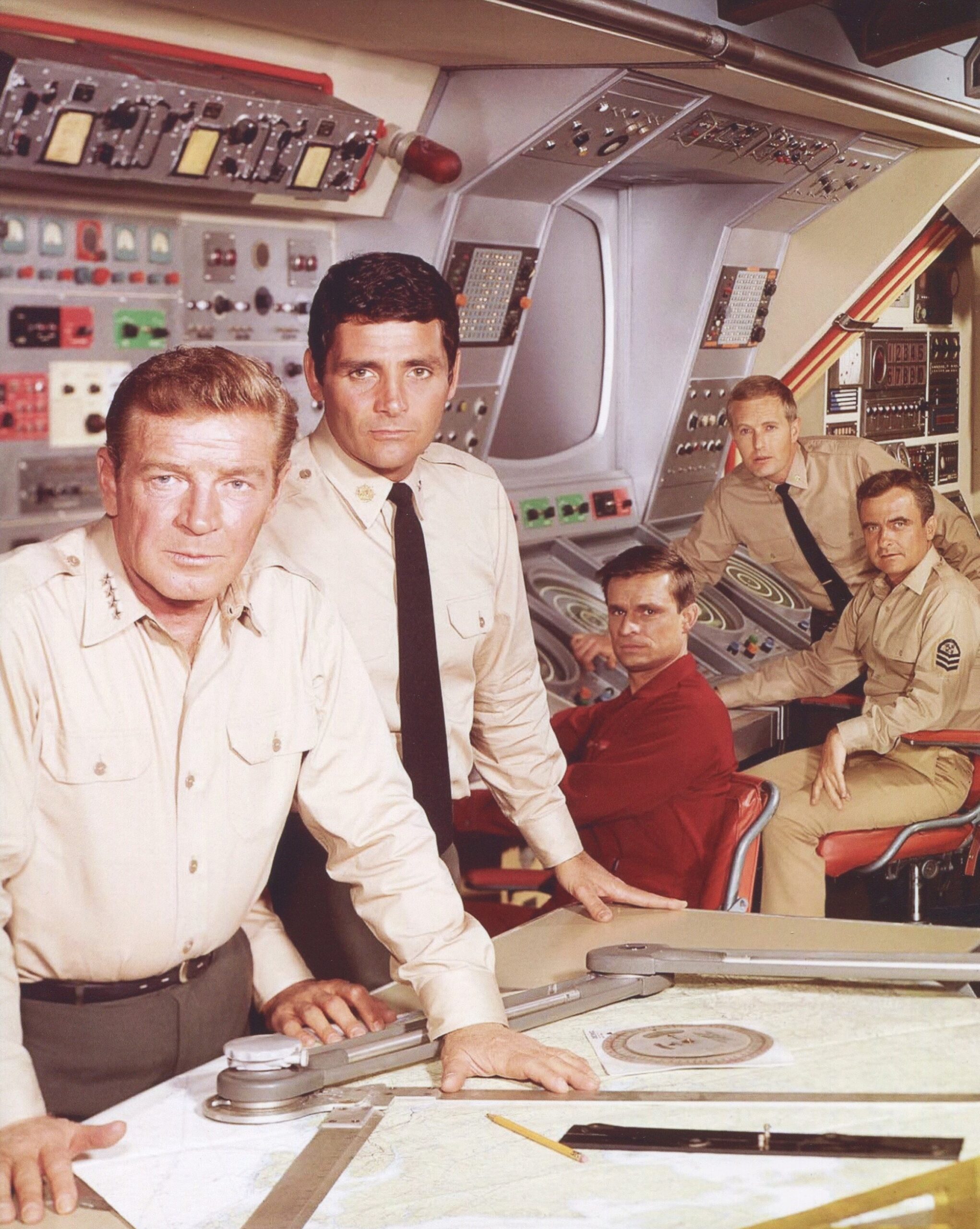
Cast photo: (L-R) Richard Basehart, David Hedison, Del Monroe, Robert Dowdell, and Terry Becker.
—
David Hedison: Prior to playing Captain Lee Crane, Hedison was probably best known as the scientist who underwent the transformation in The Fly (1958). At that time, he was known as Al Hedison (he was born as Albert David Hedison Jr.) but the name change occurred when he was cast as the lead in the short-lived 1959-60 TV series Five Fingers, and the studio liked “David” better. He also co-starred in the Irwin Allen film The Lost World (1960). Allen had wanted him as Crane for the Voyage to the Bottom of the Sea movie but Hedison turned it down due to bad memories of working on The Lost World. Later, for the television version of Voyage, Allen kept phoning him to play Crane and Hedison kept turning him down. However, when Allen told him that Richard Basehart was going to pay the Admiral, Hedison accepted within seconds because he wanted to work with him.
Recommended David Hedison episode to watch: “Edge of Doom” Season 4, Episode 24.
—
Del Monroe: As Seaman Kowalski, Monroe repeated his role from the motion picture (in the film, he was Seaman Kowski). He was the only actor from the movie to become part of the regular cast during the run of the show. (Mark Slade had also been in the movie as a seaman but only appeared in a few episodes of the TV series’ first season. He would go on to greater success in television’s The High Chaparral.) A few other actors from the film showed up in guest spots but that was all.
Recommended Del Monroe episode to watch: “Deadly Waters” Season 3, Episode 7.
—
Robert Dowdell: The role of Lieutenant Commander Chip Morton was given to Dowdell through the recommendation of his neighbor, David Hedison. Prior to Voyage, he had been a regular on the Jack Lord TV series Stoney Burke.
Recommended Robert Dowdell episode to watch: “Journey With Fear” Season 4, Episode 4. (Yes, it is one of Voyage’s monster-of-the-week stories but Chip Morton is featured prominently.)
—
Terry Becker: In the first season, Chief Petty Officer Curley Jones was played by Henry Kulky. Regrettably, Kulky died of a heart attack on February 12, 1965, while reading the script for an upcoming Voyage. For the second season, he was replaced by Terry Becker as C.P.O. Francis Ethelbert Sharkey (not to be confused with the Don Rickles’ sitcom, C.P.O. Sharkey). What many don’t know is that after Voyage, Becker became a director and producer. Among his behind-the-camera work was acting as associate producer of the highly-respected Room 222 (and he directed several episodes).
Recommended Terry Becker episode to watch: “The Death Watch” Season 3, Episode 9.
—
The Seaview and the Flying Sub: In the movie and the series, the storyline credits Nelson as the creator and builder of the Seaview. Of course, in real life, the design of the Seaview for the original movie was turned over to 20th Century-Fox art directors Jack Martin Smith and Herman Blumenthal. But for all the glory given to the Seaview, the Flying Sub introduced in the series’ second season was way more cool. The Seaview just moved through the water (though sometimes it took a dramatic turn by rising nose-first out of the ocean like a whale and then came plopping down with a mighty splash). But the Flying Sub (designed by William Creber), oh boy, the two-person craft was sleek and could fly (obviously) and dart around from place to place above the water and dive under it.
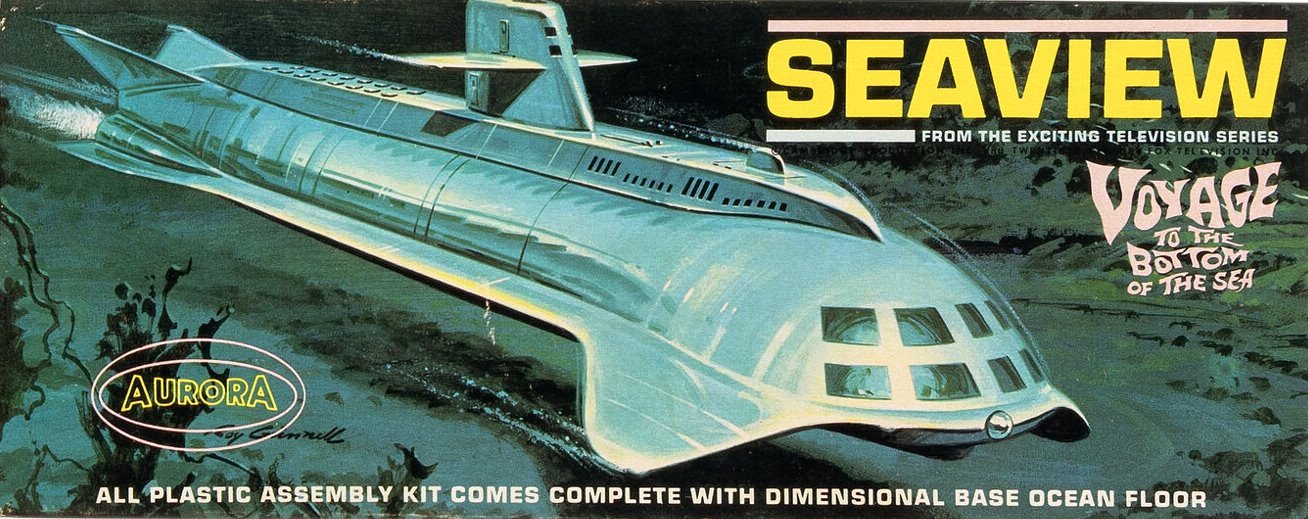
Aurora model kit of the Seaview.
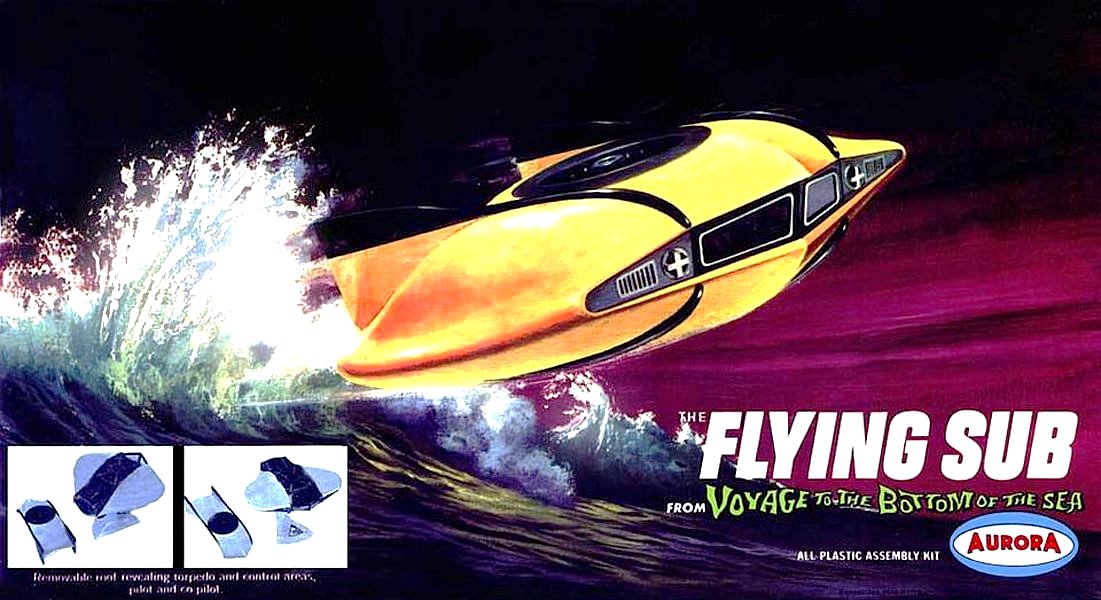
Aurora model kit of the Flying Sub.
—
Merchandising: There were a number of tie-ins to the series, including games, View-Master 3D reels, lunch box and Thermos kits, gum cards, toys including a “submarine gun,” jigsaw puzzles and, naturally, a comic book series.
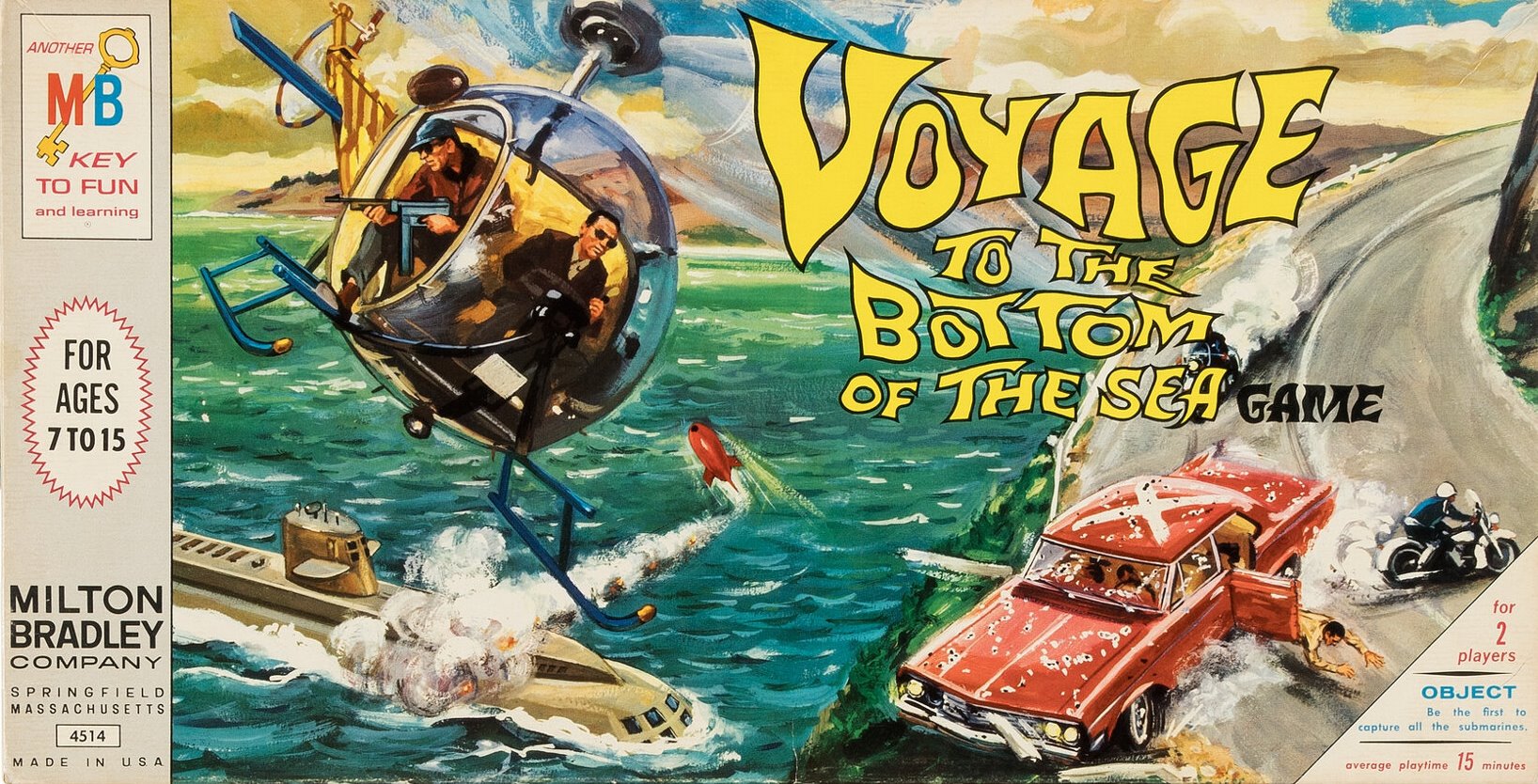
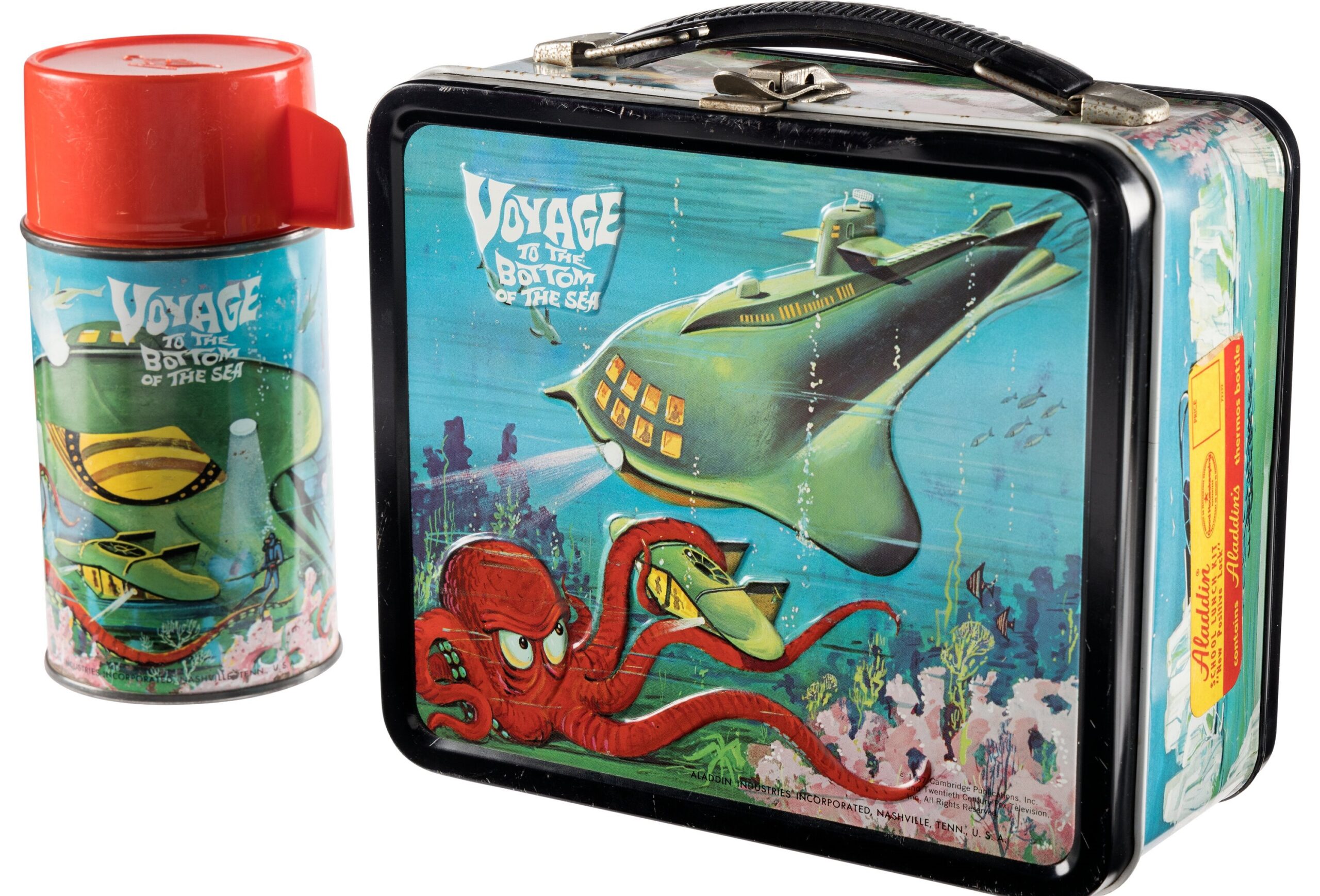
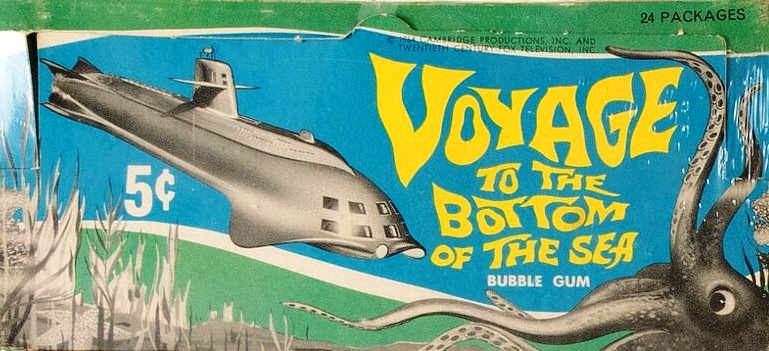
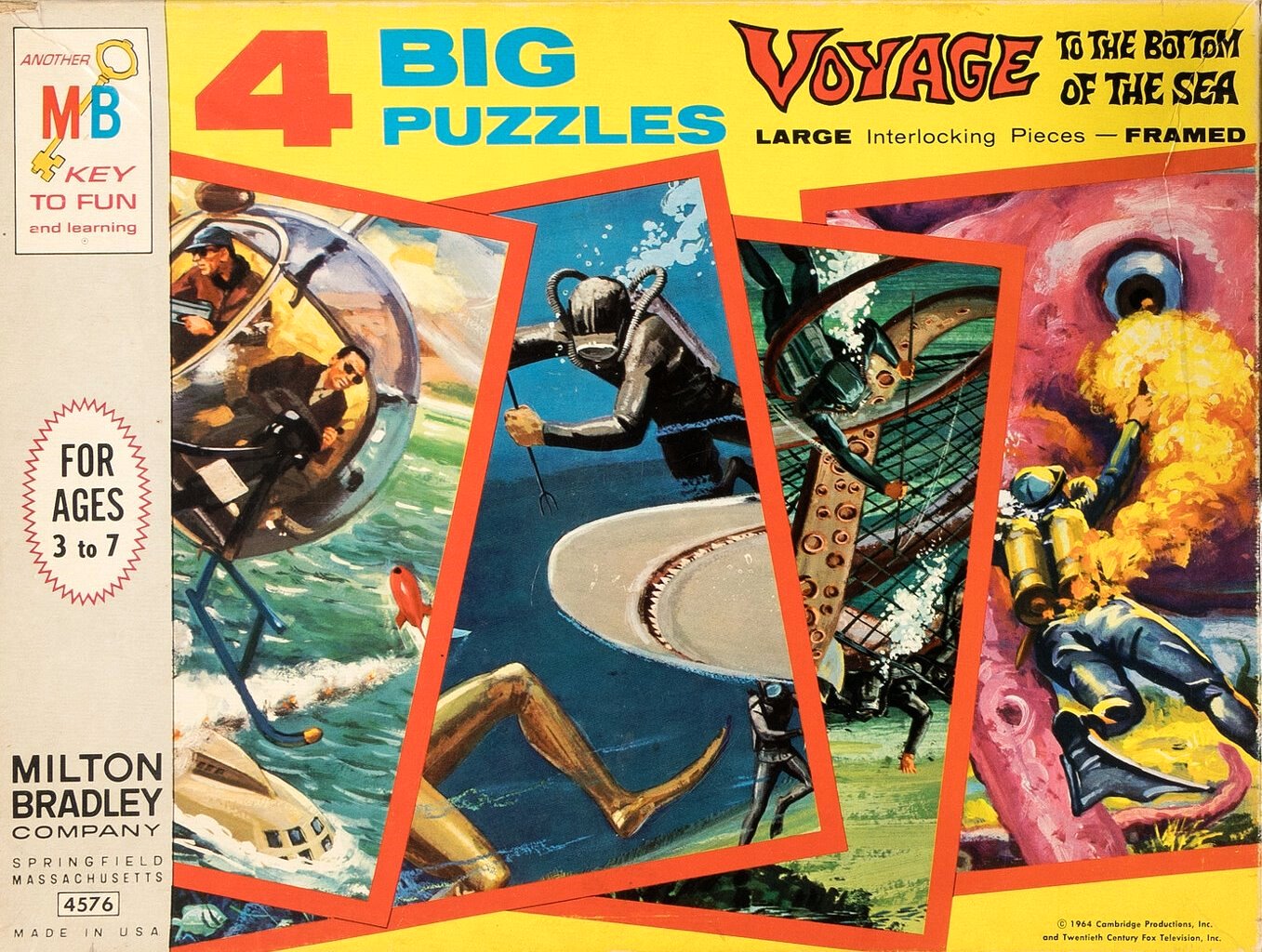
—
Comic Books. For the film, Dell issued a comic book adaptation (Four Color #1230) and Gold Key got the licensing rights to the TV program a few years later, with the comic book series lasting 16 issues, from December 1964 to April 1970 (however, the last two were reprints from Issues #6 and #7). The artists during the run included Mike Sekowsky, Don Heck, George Tuska, and Alberto Giolitti. The scripts, though, by undetermined writers, were pretty terrible.
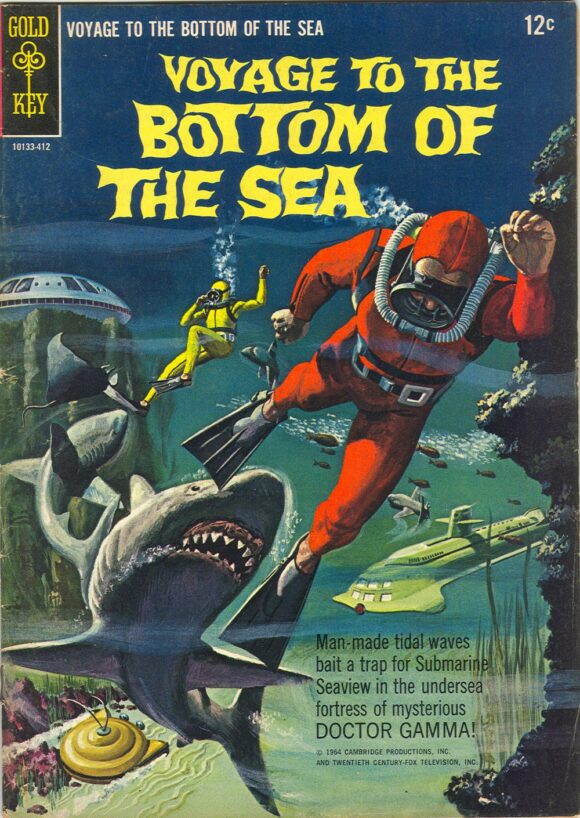
Voyage to the Bottom of the Sea #1 (Dec. 1964, Gold Key). Cover painting possibly by George Wilson.
—
The Irwin Allen School of Rock and Roll: Okay, there really wasn’t one, but there should have been. Years before Star Trek had the Enterprise crew suddenly being knocked off balance to the left and then to the right by some attacker, the Voyage to the Bottom of the Sea actors had it down to a science. If you were in an Irwin Allen project, you would become an expert (also check out his Lost in Space, Land of the Giants, and The Time Tunnel). David Hedison said, “There was a guy on set with a metal pail and a hammer. When he hit the pail the first time, we all lurched to the right. On the second hit, we’d fall to the left as the camera tilted to the right. A hammer and an old tin pail. Can you imagine!”
—
MORE
— The TOP 13 STAR TREK EPISODES — RANKED. Click here.
— The TOP 13 EPISODES of THE (U.K.) AVENGERS — RANKED. Click here.
—
13th Dimension contributor-at-large PETER BOSCH’s first book, American TV Comic Books: 1940s-1980s – From the Small Screen to the Printed Page, was published by TwoMorrows. A sequel, about movie comics, is coming soon. Peter has written articles and conducted celebrity interviews for various magazines and newspapers. He lives in Hollywood.


September 15, 2024
For years I ridiculed it as a “Monster Show,” but I’ve been watching the fine (and fun) analysis on the You Tube channel “Irving’s Zoo.” Some episodes feature fine character studies, some are solid thriller plots and there is some wonderful acting!
September 17, 2024
The show had its ridiculous moments (particularly in Seasons 3 and 4) but Season 1 is pretty terrific and Season 2 has many excellent moments.
Watch Season 1 episodes “Doomsday” and “Submarine Sunk Here”…outstanding episodes
September 17, 2024
I always thought Terry becker would have been perfect to play jack kirby in a film